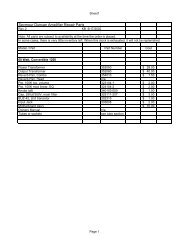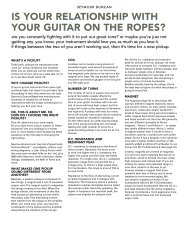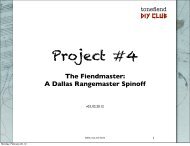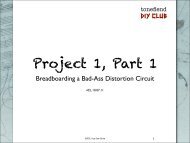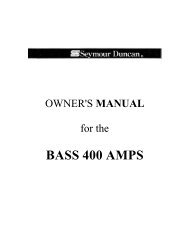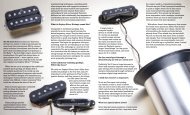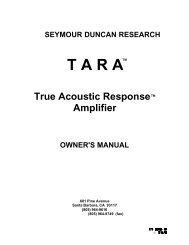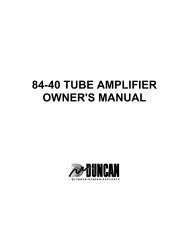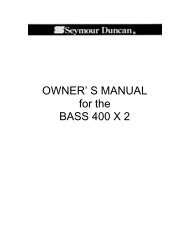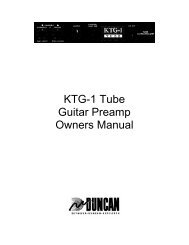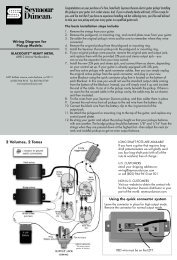Biamp 8000 Owner's Manual - Seymour Duncan
Biamp 8000 Owner's Manual - Seymour Duncan
Biamp 8000 Owner's Manual - Seymour Duncan
Create successful ePaper yourself
Turn your PDF publications into a flip-book with our unique Google optimized e-Paper software.
<strong>Seymour</strong> <strong>Duncan</strong><br />
<strong>Biamp</strong> <strong>8000</strong><br />
<strong>Owner's</strong> <strong>Manual</strong>
Dear <strong>Seymour</strong> <strong>Duncan</strong> <strong>Biamp</strong> <strong>8000</strong> Owner:<br />
If you're like most musicians I know, the first thing you want to do is plug-in your now amp and<br />
start playing --- the last thing you want to do is read an owner's manual. Go ahead, play the amp<br />
and see what it can do for you.<br />
Once you've completed the "breaking in" experience, please read through this manual. The amp<br />
is designed to give you versatility from functional controls and switches. This manual will show<br />
you the easy way of getting a wide variety of great sounds just by properly setting up your <strong>Biamp</strong><br />
<strong>8000</strong>.<br />
Enjoy it. If you have any comments about the design of your amp, I'd like to hear from you. If you<br />
have any ideas for other related products, please write me at the address below.<br />
Thank you.<br />
P.S. If you haven't mailed in your warranty card, please do it now. It may seem like a hassle, but<br />
it's the only way we have to verify warranty status of your amp.<br />
<strong>Seymour</strong> <strong>Duncan</strong><br />
5427 Hollister Avenue<br />
Santa Barbara, CA 93111<br />
Tel: 805-964-9610<br />
Fax: 805-964-9749<br />
www.seymourduncan.com
Table of Contents<br />
Page<br />
1 Modes of Operation<br />
2-3 Front Panel Controls<br />
4-5 Rear Panel Controls<br />
6-7 Troubleshooting<br />
7 Specifications<br />
8 Schematic Drawing<br />
9 Professional Bass Gear<br />
Unpacking<br />
Inspect your bass amp for hidden damage that may have occurred in transit. Your amp was<br />
inspected and sound tested before shipment from the factory.<br />
All claims for shipping damage must be made by the receiver. Save your box and packing<br />
material for evidence of damage if it has occurred.<br />
Packaging Materials<br />
The original box and packing materials are specially designed to protect your amp during<br />
shipment.<br />
- SAVE ALL PACKAGING MATERIALS.<br />
In the unlikely event that your amp needs to be returned to the factory, the original box and<br />
packing material will be necessary for shipment. These are carrier approved packing materials<br />
and they will insure safe transit back to the factory.<br />
Warnings<br />
- To reduce the risk of fire or electrical shock, DO NOT expose this amplifier to rain or moisture.<br />
- Make all speaker connections before plugging unit in.<br />
- DO NOT disconnect the speaker while the amp is turned on.<br />
- DO NOT restrict air movement around the fan intake or the air outlet on the back of the amp.<br />
- DO NOT test the amplifier's operation by touching the tip of the input cable with your finger. This<br />
is a very wide bandwidth amp and the extreme amount of radio frequency energy caused by<br />
doing this can cause damage to the amp and your speaker system.
Modes of Operation- Speaker Hookup<br />
To Full Range Cabinet<br />
Bridged Mono Mode<br />
Optimum Load 8 ohms<br />
To Full Range Cabinet<br />
Dual Mono Mode<br />
Optimum Load 4 ohms<br />
To Full Range Cabinet<br />
To High Frequency Cabinet<br />
<strong>Biamp</strong> Mode<br />
Optimum Load 4 ohms<br />
To low Frequency Cabinet
<strong>Biamp</strong> <strong>8000</strong> Front Panel Controls<br />
1. Volume: This control sends the signal volume from the preamp to the power amplifier. Turning<br />
the knob clockwise increases volume.<br />
2. Bass Input: Plug your bass in here. Input impedance is I Meg ohm.<br />
3. Power Indicator: When your amp is on, this L.E.D. will glow. The <strong>Biamp</strong> <strong>8000</strong> uses an L.E.D.<br />
instead of a normal bulb because L.E.D.'s last up to 10 times longer.<br />
4. Power Level Indicators: These L.E.D.'s show the amount of power being demanded from the<br />
power amp. The bottom orange L.E.D. indicates 3 dB below rated power. The bottom red L.E.D.<br />
shows 3 dB past the rated power.<br />
Sustained operation in the top red L.E.D. region can cause severe damage to speaker systems<br />
due to the high level of distortion.<br />
5. Graphic Equalizer: This is an active equalizer system that provides 15 dB of boost and cut<br />
(total range is 30 dB) per band. Each band of the E.Q. is independent. You can vary the individual<br />
bands as much as you want without affecting the range of the other E.Q. controls.<br />
By combining the graphic equalizer with the low contour switch, it is possible to achieve 30 dB of<br />
gain boost at very low frequencies. Because the power amp is easily capable of providing very<br />
low frequencies there is a potential threat to damaging speaker systems through cone<br />
over-excursion. Exercise caution when playing at high volume levels with large amounts of low<br />
frequency boost. When playing outdoors, it may prove beneficial to slightly cut low frequencies to<br />
provide more headroom and louder playing volume.<br />
6. Low Frequency Contour: switch provides 15 dB boost at 80 hz. It is especially useful<br />
when playing at lower volumes to create a "warm" sound.
7. High Frequency Contour: This switch provides 15 dB of boost at 4 kHz. It is very useful for<br />
giving you extra presence or edge.<br />
8. <strong>Biamp</strong>/Mono Switch: Use this switch to select <strong>Biamp</strong> or Dual Mono operation. In the <strong>Biamp</strong><br />
mode, the built-in crossover is activated - low frequencies are sent through the low channel and<br />
high frequencies are sent through the high channel. In the Mono mode, the same signal is sent<br />
through both channels.<br />
9. Bridge Switch: Use this switch to change amp operation into and out of the bridge mode.<br />
Bridge mode combines the two output sections into a single one. You'll get almost twice the<br />
power (600 watts) into twice the load (8 ohms). Using the Bridge mode forces the amp into a<br />
mono operation, i.e. you cannot run your amp in Bridge mode and <strong>Biamp</strong> mode at the same time.<br />
10. Bridge Mode Indicator L.E.D.: This shows you that the bridge switch is activated and that<br />
the amp is running in Bridge mode.<br />
11. Variable Crossover: This is a single order crossover that is continuously variable from 100<br />
Hz to 1khz. The optimum crossover point will vary according to the speakers you use. Experiment<br />
to see where you like it best.<br />
12. Low Master Volume: Use this control to set the volume of the low frequency channel in the<br />
<strong>Biamp</strong> mode. In the Dual Mono mode, this control affects the speaker plugged into the lower<br />
speaker Jack. In the Bridge mode, this control operates as a master volume.<br />
13. High Master Volume: Use this control to set the volume of the high frequency channel in the<br />
<strong>Biamp</strong> mode. In the Dual Mono mode this control affects the speak er plugged into the upper<br />
speaker Jack. In the Bridge mode, this control is non-functional.
<strong>Biamp</strong> <strong>8000</strong> Rear Panel Controls<br />
1. On/Off/On Switch: This switch is designed to turn your amp on and to allow you to reverse the<br />
A.C. polarity. If you're picking up 60 Hz hum from the wall current, put the "On" switch in the other<br />
"On" position.<br />
- If you're using other equipment, like a P.A., and you get a shock when touching the microphone,<br />
place the "On" switch in the other "On" position to eliminate the shock. The middle position is<br />
"Off."<br />
Turning the switch on will automatically start the built in fan to keep your amp running cool.<br />
2. Fuse Holder: The fuse is located in the cap of the fuse holder. If the fuse falls, it must be<br />
replaced with one that provides proper current protection or you w-ill void the warranty. The<br />
proper fuse rating for the 110-120 V.A.C. <strong>Biamp</strong> <strong>8000</strong> amp is ABC10.<br />
Before removing the fuse cap:<br />
UNPLUG THE POWER CORD FROM THE WALL A.C. OUTLET.<br />
After checking the fuse cap, you can plug the amp back into the wall.<br />
To remove the fuse cap, simply grasp the cap with your fingers, push in, and turn counterclockwise.<br />
To replace the cap, grasp the cap with your fingers, push in, and turn clockwise.<br />
Fuses are protective devices that prevent the electronics from damage if there is a serious<br />
electrical problem. If your amp repeatedly has fuse failures, check the trouble-shooting page<br />
under "Fuse Failure."<br />
3. Balanced Line Output: Use this jack for patching the output signal of the amp directly into a<br />
mixer or tape recorder. This circuit is wired post-E.Q. so all tone settings will affect the outgoing<br />
signal. Output is one volt at full power.
The standard three pin XLR jack allows you to use a balanced line so you can run your cord for<br />
long distances with no signal loss and no hum.<br />
Output impedance is 600 ohms.<br />
4. Speaker Jacks: These output jacks accept standard banana plugs.<br />
In the <strong>Biamp</strong> and Dual Mono modes, optimum amplifier performance is realized -with a 4-ohm<br />
speaker load.<br />
An 8-ohm load will yield less power. A 2-ohm load will yield more power but under very demanding<br />
conditions (like extremely high volume settings) the current limiting circuit may engage<br />
and cause audible distortion.<br />
In the Bridge mode, optimum amplifier performance is realized with an 8-ohm load. A 4-ohm load<br />
is not recommended.<br />
See page 3 for the diagrams showing proper hook-up configurations for the different operations<br />
modes.<br />
5. Effects Loop: Use this circuit with your effects for the least amount of hiss. In older design<br />
amps, players had to plug their basses directly into effects and plug the effects into the input<br />
jacks on their amps.<br />
With the <strong>Biamp</strong> <strong>8000</strong>, you can plug your bass into the Bass Input Jack and run your effects<br />
through the Effects Loop.<br />
"Effects Send" should be connected to the input of your effect using a normal guitar cable.<br />
"Effects Return" should be connected to the out put of your effect using a normal guitar cable.<br />
You want the signal to come OUT of your amp INTO the effect and OUT of the effect INTO your<br />
amp.<br />
Output impedance is 10k ohms.
Troubleshooting<br />
The following table should enable you, with little or no knowledge of electronics, to isolate the<br />
cause of some problems you may experience with your amplifier and the steps required for<br />
repair. Most causes of impaired amplifier performance are due to minor problems or irregularities,<br />
which can be easily corrected by you. However, if you cannot identify the cause of the problem<br />
using the table below, or if it indicates your amplifi er to be defective and in need of repair, return<br />
the unit to an Authorized <strong>Seymour</strong> <strong>Duncan</strong> Service center or call (805) 964-9610 for a Return<br />
Authorization number.<br />
Symptom Probable Cause Remedy<br />
Amp does not light up and<br />
come on when power switch is<br />
"On."<br />
1.) Power not connected, 1.) Ensure power cord is<br />
plugged into operative power<br />
outlet.<br />
2.) Blown amp fuse. 2.) Check amp fuse: replace if<br />
blown with ABC-10. If it<br />
continues to blow, call a<br />
Amp lights up, but no sound<br />
comes out when power switch<br />
is on.<br />
Distorted sound.<br />
Muddy sound.<br />
Buzzing sound.<br />
service center.<br />
1.) Bad guitar cable. 1.) Replace cable.<br />
2.) Bad speaker cable. 2.) Replace cable.<br />
3.) Effects are hooked up 3.) Reverse hook-up cables.<br />
backwards in effects loop.<br />
4.) Defective effects. 4.) Remove effects.<br />
5.) Blown speaker. 5.) Hook up new speaker.<br />
6.) Internal fuse blown. (Only<br />
on very early models.)<br />
6.) Replace with ABC-10 (See<br />
diagram). If it continues to<br />
blow, call service center.<br />
1.) Partially shorted speaker 1.) Replace cable.<br />
cable.<br />
2.) Speaker impedance is 2.) See manual for minimum<br />
below recommended value. load.<br />
3.) Master Volume set too low. 3.) Set control at minimum 3<br />
o'clock.<br />
4.) Over boosted E.Q. 4.) Set E.Q. settings<br />
settings.<br />
moderately.<br />
5.) Defective or overdriven 5.) Remove effect or reduce<br />
effect.<br />
input sensitivity.<br />
6.) Defective speaker. 6.) Replace speaker.<br />
7.) Low battery (Active 7.) Replace battery in pickups.<br />
pickups.)<br />
1.) E.Q. setting too high in 1.) Reduce low frequency E.Q.<br />
lower frequency ranges. settings.<br />
2.) Speakers are wired for 2.) Reverse switch position to<br />
Bridge mode, but <strong>Biamp</strong>/ Mono.<br />
Mono switch is set on <strong>Biamp</strong>.<br />
1.) Ground loop (in rack mount 1.) Reverse ground or lift<br />
installations.)<br />
ground and reground the rack.<br />
2.) Improperly wired<br />
2.) Check instrument wiring.<br />
instrument.<br />
3.) Noisy A.C. line. 3.) Reverse polarity of power<br />
switch.
Specifications for the <strong>Biamp</strong> <strong>8000</strong><br />
Power- Bi-amp mode: 400 watts bottom end into 4 ohms; 400 watts high end into 4 ohms.<br />
Dual mono mode: 400 watts x 2 mono channels into 4 ohms. Bridge mode: 600 watts into 8<br />
ohms. (All power specifications at 4 ohms, less than .05% distortion, unless otherwise noted.)<br />
Power Out: 400 watts per channel 0, 120 VAC<br />
Thd: = full Power. .2%<br />
Slew rate: 550V/µs<br />
Power bandwidth: 10hz to lOOkhz +/-3dB<br />
S/N ratio: (preamp and power amp) 84dB<br />
S/N ratio: (power amp only) 90dB<br />
Input impendance: 1 megohm<br />
Effects Loop: (Output impedance): 10k ohms<br />
Effects Loop: (Input impedance): 50k ohms<br />
Dimensions: 5.5" x 10.5" x 17.2"<br />
Weight: 36 lbs.<br />
Power requirements: 1200 watts line current required for 400 watts output, with both channels<br />
running.<br />
Output Transformer- 120 VAC, internally selectable for lOOv/50hz or 240v/50hz.<br />
(All specifications subject to change without notice.)



